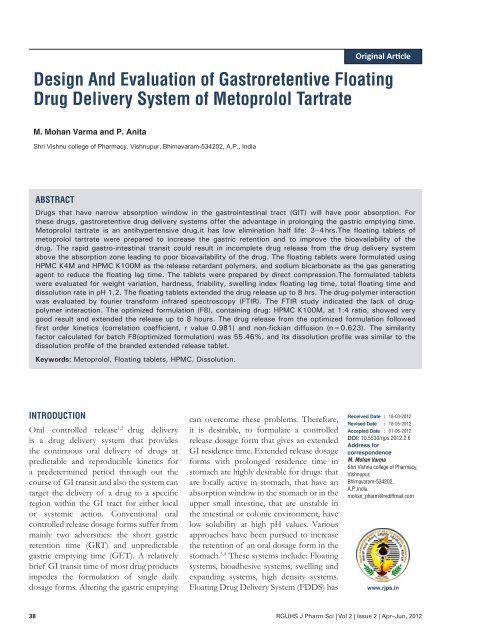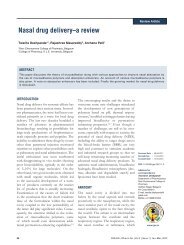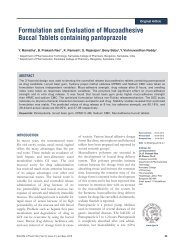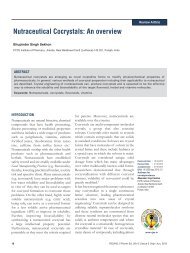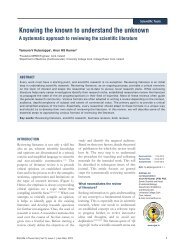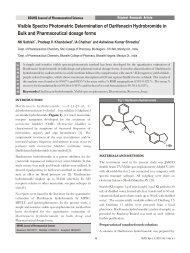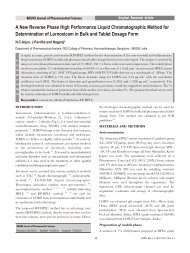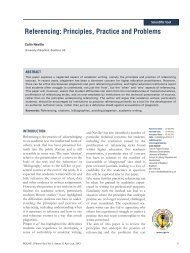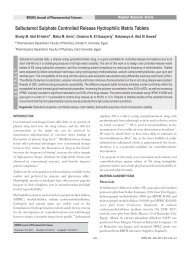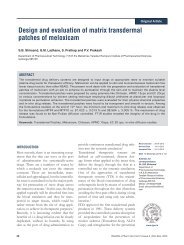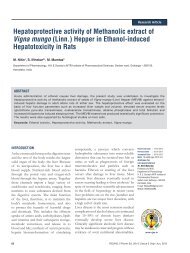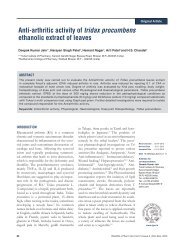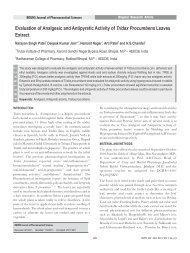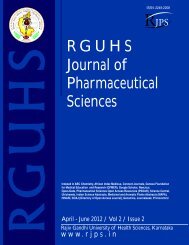RGUHS J Pharm Sci_2_2_06.pdf
RGUHS J Pharm Sci_2_2_06.pdf
RGUHS J Pharm Sci_2_2_06.pdf
Create successful ePaper yourself
Turn your PDF publications into a flip-book with our unique Google optimized e-Paper software.
Design And Evaluation of Gastroretentive Floating<br />
Drug Delivery System of Metoprolol Tartrate<br />
M. Mohan Varma and P. Anita<br />
Shri Vishnu college of <strong>Pharm</strong>acy, Vishnupur, Bhimavaram-534202, A.P., India<br />
ABSTRACT<br />
Drugs that have narrow absorption window in the gastrointestinal tract (GIT) will have poor absorption. For<br />
these drugs, gastroretentive drug delivery systems offer the advantage in prolonging the gastric emptying time.<br />
Metoprolol tartrate is an antihypertensive drug,it has low elimination half life: 3–4 hrs.The floating tablets of<br />
metoprolol tartrate were prepared to increase the gastric retention and to improve the bioavailability of the<br />
drug. The rapid gastro-intestinal transit could result in incomplete drug release from the drug delivery system<br />
above the absorption zone leading to poor bioavailability of the drug. The floating tablets were formulated using<br />
HPMC K4M and HPMC K100M as the release retardant polymers, and sodium bicarbonate as the gas generating<br />
agent to reduce the floating lag time. The tablets were prepared by direct compression.The formulated tablets<br />
were evaluated for weight variation, hardness, friability, swelling index floating lag time, total floating time and<br />
dissolution rate in pH 1.2. The floating tablets extended the drug release up to 8 hrs. The drug-polymer interaction<br />
was evaluated by fourier transform infrared spectroscopy (FTIR). The FTIR study indicated the lack of drugpolymer<br />
interaction. The optimized formulation (F8), containing drug: HPMC K100M, at 1:4 ratio, showed very<br />
good result and extended the release up to 8 hours. The drug release from the optimized formulation followed<br />
first order kinetics (correlation coefficient, r value 0.981) and non-fickian diffusion (n=0.623). The similarity<br />
factor calculated for batch F8(optimized formulation) was 55.46%, and its dissolution profile was similar to the<br />
dissolution profile of the branded extended release tablet.<br />
Keywords: Metoprolol, Floating tablets, HPMC, Dissolution.<br />
INTRODUCTION<br />
Oral controlled release 1,2 drug delivery<br />
is a drug delivery system that provides<br />
the continuous oral delivery of drugs at<br />
predictable and reproducible kinetics for<br />
a predetermined period through out the<br />
course of GI transit and also the system can<br />
target the delivery of a drug to a specific<br />
region within the GI tract for either local<br />
or systemic action. Conventional oral<br />
controlled release dosage forms suffer from<br />
mainly two adversities: the short gastric<br />
retention time (GRT) and unpredictable<br />
gastric emptying time (GET). A relatively<br />
brief GI transit time of most drug products<br />
impedes the formulation of single daily<br />
dosage forms. Altering the gastric emptying<br />
can overcome these problems. Therefore,<br />
it is desirable, to formulate a controlled<br />
release dosage form that gives an extended<br />
GI residence time. Extended release dosage<br />
forms with prolonged residence time in<br />
stomach are highly desirable for drugs: that<br />
are locally active in stomach, that have an<br />
absorption window in the stomach or in the<br />
upper small intestine, that are unstable in<br />
the intestinal or colonic environment, have<br />
low solubility at high pH values. Various<br />
approaches have been pursued to increase<br />
the retention of an oral dosage form in the<br />
stomach. 3,4 These systems include: Floating<br />
systems, bioadhesive systems, swelling and<br />
expanding systems, high density systems.<br />
Floating Drug Delivery System (FDDS) has<br />
Original Article<br />
Received Date : 18-03-2012<br />
Revised Date : 18-05-2012<br />
Accepted Date : 01-06-2012<br />
DOI: 10.5530/rjps.2012.2.6<br />
Address for<br />
correspondence<br />
M. Mohan Varma<br />
Shri Vishnu college of <strong>Pharm</strong>acy,<br />
Vishnupur,<br />
Bhimavaram-534202,<br />
A.P.,India.<br />
mohan_pharm@rediffmail.com<br />
www.rjps.in<br />
38 <strong>RGUHS</strong> J <strong>Pharm</strong> <strong>Sci</strong> | Vol 2 | Issue 2 | Apr–Jun, 2012
M. Mohan Varma et al.: Design And Evaluation of Gastroretentive Floating Drug Delivery System of Metoprolol Tartrate<br />
a bulk density lower than gastric fluids and thus remain<br />
buoyant in the stomach for a prolonged period of time,<br />
without affecting the gastric emptying rate. 5,6 While the<br />
system is floating on the gastric contents, the drug is<br />
released slowly at a desired rate from the system. After<br />
the release of the drug, the residual system is emptied<br />
from the stomach. This, results in an increase in the<br />
GRT and a better control of the fluctuations in the<br />
plasma drug concentration.<br />
Based on the mechanism of buoyancy, two distinctly<br />
different technologies have been utilized in development<br />
of FDDS which are : effervescent system and the noneffervescent<br />
system. 7 Effervescent systems include<br />
use of gas generating agents, carbonates (e.g. sodium<br />
bicarbonate) and organic acid (e.g. citric acid and<br />
tartaric acid) present in the formulation to produce<br />
carbon dioxide (CO 2 ) gas, thus reducing the density<br />
of the system and making it float on the gastric fluid.<br />
The non-effervescent FDDS is based on mechanism<br />
of swelling of the polymer or mucoadhesion to the<br />
mucosal layer in the GI tract. The most commonly used<br />
excipients in non-effervescent FDDS are gel forming<br />
or highly swellable cellulose type hydrocolloids,<br />
polysaccharides and the matrix forming materials<br />
such as Polycarbonate, Polyacrylate, Polymethacrylate,<br />
Polystyrene as well as mucoadhesive polymer such as<br />
Chitosan and Carbopol.<br />
Metoprolol 8,9 is a β1 selective adrenergic receptor<br />
blocking agent. It is a widely used antihypertensive<br />
drug. Metoprolol tartrate is a water soluble drug, it is<br />
administered orally, initially at a dose of 50 mg, 3–4<br />
tissues/day gradually increased to a maximum dose<br />
of 200 mg/day in divided doses. It has an elimination<br />
half life of 3–4 hours and has an absorption zone from<br />
the upper intestinal tract. Efficacy of the administered<br />
dose may get diminished due to incomplete drug release<br />
from the device above the absorption zone. Therefore,<br />
it is a suitable drug for gastroretentive formulation. The<br />
gastroretentive drug delivery systems can be retained in<br />
the stomach and assist in improving the oral sustained<br />
delivery of drugs that have an absorption window in<br />
a particular region of the gastrointestinal tract. These<br />
systems help in continuously releasing the drug before it<br />
reaches the absorption window , thus ensuring optimum<br />
bioavailability.<br />
In the context of the above principles, a strong need was<br />
recognized for the design of a dosage form to deliver<br />
metoprolol in the stomach and to increase the efficiency<br />
of the drug, providing controlled release action. The<br />
drug is subjected to first pass metabolism and its oral<br />
bioavailability is 50%. The drug is mainly absorbed in the<br />
stomach and in the upper part of duodenum, hence it is<br />
ideally suited for the gastroretentive floating tablets. The<br />
objective of the study is to formulate Metoprolol tartrate<br />
floating tablets , to increase the gastric retention , extend<br />
the drug release and to improve its oral bioavailability.<br />
MATERIALS AND METHODS<br />
Metoprolol tartrate was a gift sample from Hetero<br />
Drugs Ltd, Hyderabad. HPMC K4M, HPMC K100M,<br />
microcrystalline cellulose (MCC), magnesium stearate,<br />
sodium bicarbonate and talc were procured from SD<br />
Fine Chemicals, Mumbai. All other chemicals used were<br />
of analytical grade.<br />
Estimation of metoprolol tartrate<br />
A spectrophotometric 3 method based on the measurement<br />
of absorbance at 221 nm in 0.1N HCl was used<br />
in the present study for the estimation of Metoprolol<br />
tartrate. The 100 mg of Metoprolol tartrate pure drug<br />
was dissolved in 100 ml of 0.1 N HCl (stock solution<br />
1000 μg/ml), from this 10 ml of solution was taken<br />
and the volume was adjusted to 100 ml with 0.1 N HCl<br />
(100 μg/ml). The above solution was subsequently<br />
diluted with 0.1N HCl to obtain the series of dilutions<br />
containing 2,4,6,8,10,12,16,20,24 and 30 μg/ml of<br />
Metoprolol tartrate solution. The absorbance of the<br />
above dilutions was measured at 221 nm by using<br />
the UV-spectrophotometer (Lab. India) using 0.1N<br />
HCl as the blank. Then a graph was plotted by taking<br />
concentration on x-axis and absorbance on y-axis which<br />
gives a straight line (Figure 1).<br />
Preparation of metoprolol tartrate<br />
floating tablets<br />
All the formulations were prepared by direct compression 4<br />
method using different viscosity grades of HPMC<br />
polymers in various ratios (designated as F-1 to F-8<br />
in Table 1). The metoprolol tartrate and all other<br />
ingredients were individually passed through sieve ≠ 60.<br />
All the ingredients were mixed thoroughly by triturating<br />
up to 15 min. The powder mixture was lubricated with<br />
talc. The single punch tablet machine (CADMACH) was<br />
used for the compression of the floating tablets. Use of<br />
ingredients in the formulation: Sodium bicarbonate was<br />
used as the gas generating agent to reduce the floating lag<br />
time. HPMC K4M and HPMC K100M were used as the<br />
release retardant polymer to obtain prolonged release of<br />
the drug up to 8 hours. Microcrystalline cellulose (MCC)<br />
was used as the diluent. Magnesium stearate and talc<br />
were used as the lubricants. The tablets were prepared<br />
by using the direct compression method.<br />
Evaluation of tablets<br />
The formulated tablets were evaluated for the following<br />
physicochemical characteristics 5 (Table 2):<br />
<strong>RGUHS</strong> J <strong>Pharm</strong> <strong>Sci</strong> | Vol 2 | Issue 2 | Apr–Jun, 2012 39
M. Mohan Varma et al.: Design And Evaluation of Gastroretentive Floating Drug Delivery System of Metoprolol Tartrate<br />
Table 1: Composition of different formulations<br />
Formulation<br />
No.<br />
Metoprolol<br />
tartrate (mg)<br />
Figure 1: Calibration curve of Metoprolol tartrate in 0.1 N HCl.<br />
HPMC K15M<br />
(mg)<br />
HPMC K100M<br />
(mg)<br />
NaHCO 3<br />
(mg)<br />
Mag. Stearate<br />
(mg)<br />
40 <strong>RGUHS</strong> J <strong>Pharm</strong> <strong>Sci</strong> | Vol 2 | Issue 2 | Apr–Jun, 2012<br />
Talc<br />
(mg)<br />
Microcrystalline cellulose<br />
(mg)<br />
F1 50 50 –– 45 3 3 154<br />
F2 50 100 –– 45 3 3 99<br />
F3 50 150 –– 45 3 3 49<br />
F4 50 200 –– 45 2.5 2.5 ––<br />
F5 50 –– 50 45 3 3 154<br />
F6 50 –– 100 45 3 3 99<br />
F7 50 –– 150 45 3 3 49<br />
F8 50 –– 200 45 2.5 2.5 ––<br />
TABLE 2: Quality Control Parameters of Metoprolol tartrate floating Tablets<br />
Formulation<br />
No.<br />
Avg. Weight (mg)<br />
(Mean ± S.D)<br />
(n =20)<br />
Hardness<br />
(kg/cm 2 )<br />
(n =3)<br />
% Friability<br />
(Mean ± S.D)<br />
(n =20)<br />
% Drug content<br />
(mg)<br />
Buoyancy<br />
Lag time<br />
(min)<br />
Total<br />
floating<br />
time(hrs)<br />
F1 283 ± 0.6 7.2 ± 0.2 0.546 97 ± 0.7 4 8 +<br />
F2 320 ± 0.9 7.5 ± 0.2 0.612 99 ± 0.5 10 8 +<br />
F3 292 ± 0.4 8 0.702 100 ± 0.3 8.6 8 +<br />
F4 291 ± 0.4 7.6 ± 0.2 0.611 99 ± 0.4 6.1 8 +<br />
F5 286 ± 0.8 7.6 ± 0.2 0.625 99 ± 0.6 5.0 8 +<br />
F6 304 ± 0.8 7.3 ± 0.4 0.655 98 ± 0.5 3 8 +<br />
F7 294 ± 0.4 7.7 ± 0.5 0.711 99 ± 0.4 8.5 8 +<br />
F8 297 ± 0.3 8.0 0.827 100 ± 0.6 8 8 +<br />
Hardness<br />
Hardness of the tablet was determined by using the<br />
Monsanto hardness tester. The lower plunger was placed<br />
in contact with the tablet and a zero reading was taken.<br />
The plunger was then forced against a spring by turning a<br />
threaded bolt until the tablet fractured. As the spring was<br />
Matrix<br />
integrity<br />
compressed a pointer rides along a gauge in the barrel to<br />
indicate the force required for the tablet to break.<br />
Weight variation<br />
The 20 tablets were selected and weighed collectively and<br />
individually. From the collective weight, average weight
M. Mohan Varma et al.: Design And Evaluation of Gastroretentive Floating Drug Delivery System of Metoprolol Tartrate<br />
was calculated. Each tablet weight was then compared<br />
with average weight to ascertain whether it was within<br />
the permissible limits or not. Not more than two of the<br />
individual weights deviated from the average weight by<br />
more than 7.5% for 300 mg tablets and none by more<br />
than double that percentage.<br />
Friability test<br />
The 20 previously weighed tablets were placed in the<br />
friability apparatus, which was given 100 revolutions and<br />
the tablets were reweighed. The percentage friability was<br />
calculated by using the following formula,<br />
Percentage friability = initial weight-final weight/<br />
initial weight × 100<br />
Drug content<br />
The 20 tablets of each formulation were weighed and<br />
powdered. The quantity of powder equivalent to 100 mg<br />
of Metoprolol tartrate was transferred in to a 100 ml<br />
volumetric flask and the volume was adjusted to 100 ml<br />
with 0.1N HCl. The sample was filtered to remove the<br />
insoluble excipients. Further 1ml of the above solution<br />
(filtrate) was diluted to 100 ml with 0.1N HCl and the<br />
absorbance of the resulting solution was observed at<br />
221 nm.<br />
In vitro buoyancy studies<br />
Figure 2: Swelling index of the floating tablets.<br />
The in vitro buoyancy was determined by floating lag<br />
time and total floating time as per the method described<br />
by Rosa et al. 10 The tablets were placed in a 100 ml beaker<br />
containing 0.1N HCl. The time required for the tablet to<br />
rise to the surface and float was determined as floating<br />
lag time (FLT) and the duration of the time the tablet<br />
constantly floats on the dissolution medium was noted<br />
as the total floating time respectively (TFT).<br />
Swelling index<br />
The swelling behavior of a dosage unit was measured<br />
by studying its weight gain. The swelling index (Table 3,<br />
Figure 2) of the tablets was determined by placing the<br />
tablets in the basket of the dissolution apparatus<br />
using dissolution medium as 0.1N HCl at 37 ± 0.5°C.<br />
After 0.5, 1, 2, 3, 4, 5, and 6 h, each dissolution basket<br />
containing tablet was withdrawn, blotted with tissue<br />
paper to remove the excess water and weighed on the<br />
analytical balance (Shimadzu, ELB300). The experiment<br />
was performed in triplicate for each time point.<br />
Swelling index was calculated by using the following<br />
formula. 6<br />
Swelling index<br />
( Wet weight of tablet − Dry weight of tablet<br />
) × 100<br />
% =<br />
Dry weight of tablet<br />
<strong>RGUHS</strong> J <strong>Pharm</strong> <strong>Sci</strong> | Vol 2 | Issue 2 | Apr–Jun, 2012 41<br />
( )
M. Mohan Varma et al.: Design And Evaluation of Gastroretentive Floating Drug Delivery System of Metoprolol Tartrate<br />
Table 3: Swelling index profile of Metoprolol tartrate<br />
floating tablets<br />
S.NO Formulation code Swelling index(%)<br />
1 F1 44.64<br />
2 F2 48.43<br />
3 F3 51.23<br />
4 F4 60<br />
5 F5 81.03<br />
6 F6 85.48<br />
7 F7 92.87<br />
8 F8 107.14<br />
Dissolution study<br />
The 900 ml of 0.1 HCl(pH 1.2) was placed in the<br />
vessel and the USP apparatus–II (paddle method) was<br />
assembled. The medium was allowed to equilibrate to<br />
temp of 37 + 0.5°C. The tablet was placed in the vessel<br />
and the vessel was covered, the apparatus was operated<br />
for 8 hours at 50 rpm. 3 At definite time intervals, 5 ml<br />
of the fluid was withdrawn; filtered and again 5 ml of<br />
the fresh fluid was replaced. Suitable dilutions were done<br />
with the blank dissolution fluid and the samples were<br />
analyzed spectrophotometrically (Lab, India) at 221 nm<br />
(Figure 3–6).<br />
Release kinetics<br />
The analysis of drug release mechanism from a<br />
pharmaceutical dosage form is an important but<br />
complicated process and is practically evident in the case<br />
of matrix systems. As a model-dependent approach, the<br />
dissolution data was fitted to four popular release models 10<br />
such as zero-order, first-order, diffusion and Peppa’s-<br />
Korsemeyer equations. The order of drug release from<br />
the matrix systems was described by using zero order<br />
kinetics or first orders kinetics. The mechanism of drug<br />
release from the matrix systems was studied by using<br />
Higuchi equation and Peppa’s- Korsemeyer equation.<br />
Zero order release kinetics<br />
It defines a linear relationship between the fraction of<br />
drug released versus time. Q = k o t. Where, Q is the<br />
fraction of drug released at time t and k o is the zero<br />
order release rate constant. A plot of the fraction of<br />
drug released against time will be linear if the release<br />
obeys zero order release kinetics.<br />
First order release kinetics<br />
Wagner assuming that the exposed surface area of a tablet<br />
decreased exponentially with time during dissolution<br />
Figure 3: Dissolution profile of Metoprolol tartrate floating tablets (F1, F2) formulations.<br />
42 <strong>RGUHS</strong> J <strong>Pharm</strong> <strong>Sci</strong> | Vol 2 | Issue 2 | Apr–Jun, 2012
M. Mohan Varma et al.: Design And Evaluation of Gastroretentive Floating Drug Delivery System of Metoprolol Tartrate<br />
Figure 4: Dissolution profile of Metoprolol tartrate floating tablets (F3, F4).<br />
Figure 5: Dissolution profile of Metoprolol tartrate floating tablets (F5, F6).<br />
<strong>RGUHS</strong> J <strong>Pharm</strong> <strong>Sci</strong> | Vol 2 | Issue 2 | Apr–Jun, 2012 43
M. Mohan Varma et al.: Design And Evaluation of Gastroretentive Floating Drug Delivery System of Metoprolol Tartrate<br />
process suggested that drug release from most of the<br />
slow release tablets could be described adequately by<br />
apparent first-order kinetics. The equation that describes<br />
first order kinetics is In (1–Q) = – K 1 t. Where, Q is the<br />
fraction of drug released at time t and k 1 is the first<br />
order release rate constant. Thus, a plot of the logarithm<br />
of the fraction of drug undissolved against time will be<br />
linear if the release obeys first order release kinetics.<br />
Higuchi equation<br />
It defines a linear dependence of the active fraction<br />
released per unit of surface (Q) on the square root of<br />
time. Q=K 2 t ½ . Where, K2 is the release rate constant.<br />
A plot of the fraction of drug released against square<br />
root of time will be linear if the release obeys Higuchi<br />
equation. 11<br />
Power law<br />
Figure 6: Dissolution profile of Metoprolol tartrate floating tablets (F7, F8 and Brand) formulations.<br />
In order to define a model, which would represent<br />
a better fit for the formulation, dissolution data was<br />
further analyzed by Peppa’s and Korsemeyer equation<br />
(Power Law). M t /M α = K.t n . Where, M t is the amount<br />
of drug released at time t and M α is the amount released<br />
at time α, thus the M t /M α is the fraction of drug released<br />
at time t, k is the kinetic constant and n is the diffusion<br />
exponent. A plot between log of M t /M α against log<br />
of time will be linear if the release obeys Peppa’s<br />
and Korsemeyer equation and the slope of this plot<br />
represents “n” value 12 .<br />
Similarity factor (f2 analysis)<br />
n f2 = 50 ∙ log { [1 + (1/n) ∑ (Rt T ) t=1 - t 2 ] –0.5 ∙ 100}<br />
Where ‘R t ’ and ‘T t ’ are the cumulative percentage drug<br />
dissolved at each of the selected n time point of the<br />
reference and test product respectively. The factor f2 is<br />
inversely proportional to the averaged squared difference<br />
between the two profiles, with emphasis on the larger<br />
difference among all the time points. 4<br />
FTIR STUDIES<br />
The FTIR studies were carried out to evaluate the drugpolymer<br />
interaction. The FTIR spectra of the drug<br />
(alone), polymer (alone) and the drug-polymer (physical<br />
mixture) were recorded by the potassium bromide pellet<br />
method 5 (Bruker model FTIR was used).<br />
RESULTS AND DISCUSSION<br />
Evaluation of tablets<br />
The objective of the present study was to prepare<br />
floating tablets of Metoprolol tartrate. These tablets<br />
were developed to prolong the gastric residence time and<br />
to increase the bioavailability of the drug. Metoprolol<br />
tartrate was chosen as a model drug because it is better<br />
absorbed in the stomach than the lower gastro intestinal<br />
tract. The tablets were prepared by direct compression<br />
technique, using polymers such as HPMC K 15M, HPMC<br />
44 <strong>RGUHS</strong> J <strong>Pharm</strong> <strong>Sci</strong> | Vol 2 | Issue 2 | Apr–Jun, 2012
M. Mohan Varma et al.: Design And Evaluation of Gastroretentive Floating Drug Delivery System of Metoprolol Tartrate<br />
K 100M and other standard excipients. Tablets were<br />
evaluated for physical characteristics such as hardness,<br />
floating capacity and weight variation. The in vitro<br />
release characteristics were evaluated for 8 hrs. Totally<br />
8 different formulations of Metoprolol tartrate were<br />
prepared by using two different polymers like HPMC<br />
K15 M, HPMC K100 M and diluent : microcrystalline<br />
cellulose in different concentrations (Table 1). All the<br />
formulations fulfilled the compendial specifications of<br />
the various quality control parameters (Table 2): weight<br />
variation, hardness, friability, drug content, floating lag<br />
time, total floating time and the matrix integrity. The<br />
values of hardness of the different formulations ranged<br />
from 7.2 to 8 kg/cm 2 . The values of friability of the<br />
different batches ranged from 0.546% to 0.827%. All<br />
the batches exhibited uniformity of drug content. The<br />
values of drug content of the different formulations<br />
ranged from 97% to 100%. The values of floating<br />
(buoyancy) lag time of all the formulations (Table 2)<br />
ranged from 3–10 minutes. The total floating time of<br />
all the formulations was 8 hours. All the formulations<br />
exhibited good matrix integrity. The sodium bicarbonate<br />
was used as a gas generating agent in order to float the<br />
tablet. The sodium bicarbonate induces CO 2 generation<br />
in the presence of dissolution medium (0.1N HCl). The<br />
gas generated is trapped and protected with in the gel<br />
formed by hydration of the polymer, thus decreasing<br />
the density of the tablet below 1 gm/mL, and the tablet<br />
becomes buoyant.<br />
Swelling studies<br />
Swelling is crucial in determining the release rate.<br />
A direct correlation between swelling and drug<br />
release was observed and the swelling indices were<br />
increased with increase in polymer concentration 6<br />
(Table 3, Figure 2). Among, all the formulations the<br />
F8 formulation containing HPMC K100M shows the<br />
best result of swelling index, where as the batch F1<br />
showed the least value of the swelling index. The values<br />
of swelling index of the different batches ranged from<br />
:44.64% to 107.14%. Based on the values of the swelling<br />
index, the different formulations can be arranged as<br />
:F8>F7>F6>F5>F4>F3>F2>F1.<br />
Dissolution study<br />
The dissolution studies of the floating tablets were<br />
conducted in 0.1N HCl (pH1.2) for 8 hours. The amount<br />
of drug released from all the formulations depends upon<br />
the concentration of the polymer used. HPMC K4M<br />
and HPMC K100M were used as the release retardant<br />
polymers, so that we can prolong the release of the water<br />
soluble drug, metoprolol tartrate. Sodium bicarbonate<br />
was used as the gas generating agent to reduce the<br />
floating lag time. The polymers: HPMC K4M and<br />
HPMC K100M showed good tablet integrity , swelling<br />
and extended the release of metoprolol tartrate. Sodium<br />
bicarbonate in the acidic environment reacts with the<br />
acid and produces carbon dioxide. The evoloved gas will<br />
get entrapped in the matrix leading to floating of the<br />
tablet. As the concentration of sodium bicarbonate was<br />
increased, the floating lag time was decreased. The higher<br />
concentration of sodium bicarbonate facilitates the drug<br />
release. Increase in sodium bicarbonate concentration<br />
increases the release rate. As the concentration of the<br />
polymer was increased in the different formulations,<br />
the rate of drug release was decreased. Similar results<br />
were obtained in the evaluation of floating tablets of<br />
atenolol, 3 ketoconazole 4 and ofloxacin. 5 Finally, the<br />
retardant effect of the polymer on the drug release<br />
can be indicated as: HPMC K100M > HPMC K15M<br />
(Figure 3–6). The dissolution rate of the marketed<br />
(branded) extended release tablet was evaluated (Figure 6).<br />
The value of the similarity factor was calculated. The<br />
similarity factor value for the optimized formulation,<br />
F8 (drug: HPMC K100M ratio, 1:4) is 55.46%, so its<br />
dissolution profile is similar to the dissolution profile of<br />
the branded extended release tablet.<br />
The values of n (diffusion exponent), K (release rate<br />
constant) and the dissolution parameters: T 25 (time taken<br />
to release 25% of the drug), T 50 (time taken to release<br />
50% of the drug) and T 75 (time taken to release 75% of<br />
the drug) computed for all the controlled release floating<br />
tablets and the marketed branded extended release tablet<br />
are represented in Table 4. Based on the values of T 25(hr),<br />
the release of the drug from the different formulations<br />
can be arranged as: F1>F2=F5>F3>F4=F6>F7>F8.<br />
Based on the values of T 50(hr), the release of the drug<br />
from the different formulations follows the order:<br />
F1=F3=F5=F6>F2>F4>F7>F8. The batches, F1 and<br />
F2 attained the value of T 75(hr) in 8 hours, the other<br />
formulations did not attain the value of T 75(hr) , even after<br />
8 hours of the dissolution study. The branded extended<br />
release tablet exhibited the values of T 25(hr) = 2.5 hour,<br />
T 50(hr) =7hour and T 75(hr) >8hours.<br />
The hydration rate of HPMC increases with an increase<br />
in the hydroxypropyl content. The solubility of HPMC<br />
is pH independent. In the present study ,HPMC was<br />
used as a hydrophilic matrix polymer because it forms a<br />
strong viscous gel on contact with the aqueous media,<br />
which may be useful in controlled delivery of highly<br />
water-soluble drugs. In an attempt to prolong the release<br />
of drug, the concentration of HPMC was increased.<br />
Faster release of the drug from the hydrophilic matrix<br />
was probably due to faster dissolution of the highly<br />
water-soluble drug from the core and its diffusion<br />
out of the matrix forming the pores for the entry of<br />
solvent molecules. Similar results were reported in<br />
the evaluation of floating tablets of hydrophilic drug,<br />
<strong>RGUHS</strong> J <strong>Pharm</strong> <strong>Sci</strong> | Vol 2 | Issue 2 | Apr–Jun, 2012 45
M. Mohan Varma et al.: Design And Evaluation of Gastroretentive Floating Drug Delivery System of Metoprolol Tartrate<br />
diltiazem HCl. 6 In vitro drug release studies revealed<br />
that the release of metoprolol tartrate from different<br />
formulations varies with the characteristics and the<br />
composition of matrix forming polymers as shown<br />
in Figure 5–8. These findings are in compliance with<br />
the ability of HPMC to form complex matrix network<br />
which leads to delay in the release of the drug from the<br />
device. 3 In the present investigation, the results indicated<br />
that as the polymer concentration and the viscosity of<br />
the polymer was increased, there was a reduction in the<br />
rate of drug release. Formulations containing higher<br />
methocel viscosity grades i.e., F5 to F8 showed slower<br />
drug release rates when compared to formulations with<br />
lower methocel viscosity grade i.e. F1 to F4 .<br />
Release kinetics<br />
The Table 5 enlists the coefficient of correlation (r) values<br />
of the different formulations. To examine the release<br />
mechanism of Metoprolol tartrate floating tablets, the<br />
results were analyzed according to Korsemeyer-Peppas<br />
equation. Release of Metoprolol from the optimized<br />
formulation (F8) was found to follow first order<br />
kinetics (correlation coefficient, r value of 0.981). The<br />
drug release from the formulations: F1,F2,F5,F6,F7,F8<br />
followed zero order kinetics (r > 0.9), where as the drug<br />
release from the formulations: F3,F4,F8 demonstrated<br />
first order kinetics (r > 0.9). The Higuchi plot showed<br />
an r valve of 0.986 for formulation F8, suggesting<br />
that the diffusion and erosion plays an important role<br />
in the controlled release. 10 The drug release from all<br />
the formulations depends on diffusion and erosion<br />
mechanism, as the Higuchi plot for all the formulations<br />
exhibited the r value > 0.9. The data was fitted to<br />
Korsemeyer equation; and the value of diffusion<br />
exponent ‘n’ (0.623) indicated that the drug release from<br />
the optimized formulation (F8) exhibited non-fickian<br />
diffusion. The n values of the different formulations<br />
ranged from 0.492 to 0.623. Hence, the drug release<br />
from all the floating formulations exhibited non-fickian<br />
diffusion (n > 0.45). The n value of the branded extended<br />
release tablet was 0.655, therefore the drug release from<br />
the brand also showed non-fickian diffusion (n>0.45).<br />
FTIR studies<br />
The FTIR studies of the pure drug, polymer (HPMC<br />
K100M) and the drug-polymer physical mixture was<br />
carried out to study the interaction between the drug<br />
and the polymer used. The FTIR spectrum of the<br />
pure drug (alone) and the polymer (alone): HPMC<br />
K100M are depicted in the Figure 7a and the Figure 7b<br />
respectively. The FTIR spectrum of the pure drug shows<br />
the characteristic FTIR peaks at 3342.05 cm –1 (O–H<br />
stretching), 3017.49 cm –1 (C–H aromatic stretching),<br />
1404.72 cm –1 (C=C aromatic stretching), 1179.5 cm –1 (C–N<br />
stretching), 2870.16 cm –1 (C–H stretching), 1421.05 cm –1<br />
(CH 2 bending). As all the FTIR peaks of the drug were<br />
observed in the drug: HPMC (1:4) physical mixture<br />
(Figure 7c), the FTIR studies 5 revealed the absence of<br />
drug- polymer interaction in the solid state.<br />
CONCLUSION<br />
Table 4: Dissolution Parameters of Metoprolol Tartrate Floating Tablets<br />
Formulation<br />
The best formulation F8 can successfully be employed<br />
as a controlled release floating drug delivery system. The<br />
effervescent based floating drug delivery is a promising<br />
approach to achieve in vitro buoyancy by using gel–<br />
forming polymer HPMC K100M and gas generating<br />
agent sodium bicarbonate. The floating matrix tablets<br />
Table 5: Release kinetics: Coefficient of correlation (r) values<br />
of different batches of Metoprolol tartrate floating tablets<br />
Formulation Zero order First order Higuchi’s Peppa’s<br />
F1 0.976 0.870 0.929 0.934<br />
F2 0.975 0.915 0.954 0.971<br />
F3 0.937 0.940 0.996 0.994<br />
F4 0.971 0.990 0.994 0.995<br />
F5 0.983 0.923 0.957 0.966<br />
F6 0.992 0.954 0.966 0.975<br />
F7 0.975 0.955 0.970 0.985<br />
F8 0.979 0.981 0.986 0.994<br />
BRAND 0.995 0.987 0.977 0.992<br />
Dissolution Parameters<br />
n K 0(mg/hr) K 1(hr-1) T 25(hr) T 50(hr) T 75(hr)<br />
F1 0.492 7.831 0.301 0.9 5 8<br />
F2 0.591 8.084 0.248 1 5.1 8<br />
F3 0.608 8.077 0.223 1.4 5 —<br />
F4 0.612 5.503 0.204 1.5 5.6 —<br />
F5 0.496 7.819 0.186 1 5 —<br />
F6 0.599 7.867 0.175 1.5 5 —<br />
F7 0.621 6.626 0.151 2 6 —<br />
F8 0.623 5.490 0.175 2.2 7 —<br />
BRAND 0.655 6.762 0.179 2.5 7 —<br />
46 <strong>RGUHS</strong> J <strong>Pharm</strong> <strong>Sci</strong> | Vol 2 | Issue 2 | Apr–Jun, 2012
M. Mohan Varma et al.: Design And Evaluation of Gastroretentive Floating Drug Delivery System of Metoprolol Tartrate<br />
Figure 7a: FTIR spectrum of metoprolol tartrate.<br />
Figure 7b: FTIR spectrum of HPMC K100M.<br />
<strong>RGUHS</strong> J <strong>Pharm</strong> <strong>Sci</strong> | Vol 2 | Issue 2 | Apr–Jun, 2012 47
M. Mohan Varma et al.: Design And Evaluation of Gastroretentive Floating Drug Delivery System of Metoprolol Tartrate<br />
Figure 7c: FTIR spectrum of drug: HPMC K 100M (1:4) physical mixture.<br />
(batch F8) containing drug: HPMC K 100M, at 1:4<br />
ratio could control the metoprolol release effectively for<br />
8 hours. The tablets demonstrated good floating time for<br />
8 hours. The FTIR study revealed the absence of the drugpolymer<br />
interaction. The floating tablets can control the<br />
fluctuations in the plasma drug concentration, increase<br />
the gastric residence time and eventually improve the<br />
bioavailability of metoprolol.<br />
ACKNOWLEDGEMENT<br />
The authors are thankful to the chairman sir, director<br />
sir,principal sir and the management of the shri vishnu<br />
college of pharmacy for providing the necessary facilities<br />
to carry out this work.<br />
REFERENCES<br />
1. Robinson JR, Lee VHL. Controlled drug delivery: Fundamentals and<br />
Applications, 2nd ed. Marcel Dekker, New York. 1987, pp. 24–36.<br />
2. Chein YW. Novel Drug Delivery Systems, 2nd ed., Marcel Dekker,<br />
New York.1992, pp. 4–56.<br />
3. Srivastava AK, Wadhwa S, Ridhurkar D, Mishra B. Oral sustained<br />
delivery of atenolol from floating matrix tablets-formulation and in vitro<br />
evaluation. Drug Dev. Ind. <strong>Pharm</strong>. 2005;31:367–74.<br />
4. Chandra Sekhar B, Shireesh Kiran R , Nagendra Babu B. Preparation<br />
and evaluation of gastro retentive floating tablets of Ketoconazole.<br />
Int. J. <strong>Pharm</strong>a Res. Develop.2010;2:174–184.<br />
5. Pramod Patil, Someshwara Rao B, Kulkarni SV. Formulation and<br />
In Vitro Evaluation of Floating Matrix Tablets of Ofloxacin. Asian J. Res.<br />
<strong>Pharm</strong>. <strong>Sci</strong>. 2011;1:17–22.<br />
6. Khan T, Nazim S, Sheikh S, Sheikh A. Design and In vitro evaluation<br />
of floating diltiazem hydrochloride tablets based on gas formation.<br />
Int. J. <strong>Pharm</strong>. Bio. <strong>Sci</strong>. 2010;3:1263–1267.<br />
7. Gangadharappa HV, Pramod KT, Shiva Kumar HG. Gastric Floating<br />
Drug Delivery Systems: A Review. Ind. J. <strong>Pharm</strong>. Edu. Res.2007;<br />
41:295–305.<br />
8. Martindale:The Complete Drug reference, 34th edn., edited by<br />
S.C. Sweetman, <strong>Pharm</strong>aceutical Press, U.K., 2005; pp.957.<br />
9. Goodman Gilman’s The <strong>Pharm</strong>acological Basis of Therapeutics,<br />
10th ed, New York. 2001; p. 176.<br />
10. Rosa M, Zia H, Rhodes T. Dosing and testing in vitro of a bioadhesive<br />
and floating drug delivery system for oral application. Int. J. <strong>Pharm</strong>.<br />
1994;105:65–70.<br />
11. Higuchi T. Mechanism of Sustained-action medication. Theoretical<br />
Analysis of rate of release of solid drugs dispersed in solid matrices.<br />
J. <strong>Pharm</strong>. <strong>Sci</strong>. 1963;51:1145–1149.<br />
12. Peppas N.A. Analysis of Fickian and Non-Fickian drug release from<br />
polymers. <strong>Pharm</strong>a Acta. Helv. 1985;60:110–111.<br />
48 <strong>RGUHS</strong> J <strong>Pharm</strong> <strong>Sci</strong> | Vol 2 | Issue 2 | Apr–Jun, 2012


